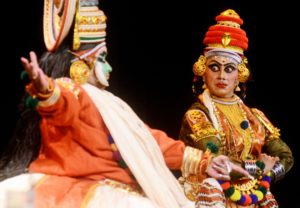There are some artistes who mesmerise on stage through their performance and then there are dancers who play the role of the opposite sex with such ease that it leaves the audience speechless. I am talking about one such superbly talented artiste who portrays both purusha vesham (male form) and stree vesham (female form) with such effortlessness that as an audience one would wonder who the real artiste is — a male or a female?
I am saying this because this is what exactly happened to me recently when I saw Prabal Gupta perform at NCPA, Mumbai. Prabal is one of the most sought after performers and choreographers in the world of Kathakali. A disciple of the Central Sangeet Natak Academy awardee and legendary Kathakali exponent and research scholar Guru Sri Sadanam Balakrishnan, Prabal is amazingly mesmerising and a versatile Kathakali dancer. He, as I mentioned before, can portray both purusha and stree vesham with immense ease and simplicity. When he takes the stree roop, you, as a viewer, are unable find out that the performer is a male artiste. That is how close and perfect Prabal gets.

Prabal initially trained under Kalamandalam Govindan Kutty and later under Guru Sri Padmanabhan. But he is one artiste who believes that dance is a lifelong learning process and this belief you can see being a part of his real life as despite being a world renowned dancer, he continues to learn under the legendary Guru Natyacharya Sri Sadanam Balakrishnanji.
At NCPA, Prabal presented a very interesting and unique show, Manasa Chitram, an exceptional presentation of a Bengali folk tale on tribal goddess Manasa in Kathakali with paintings inspired from the traditional Patachitra paintings of Bengal.
Here, Prabal portrayed the folktale as told in the oral traditions of medieval Bengal while singing as a pata gaan. The story described the conflict between Shiva devotee Chand Sadagar and tribal goddess Manasa and her struggle to attain the status of divinity. Manasa, the goddess of snakes, is worshipped across religions in Bengal, mainly for the prevention and cure of snakebites.
It was so refreshing to see such rare and lesser-known stories coming alive on stage not just through dance but even through songs and paintings. I must admit that art in its holistic way was on display at NCPA and we all need to say a big thank you to Swapnakolpa Dasgupta, an accomplished Odissi dancer herself and head of dance programming at NCPA Mumbai, for doing this.
After the fascinating show, I got talking to Prabal and asked him as to why he chose an unusual and uncommon subject like snakes over easier ones like Krishan Radha and Ram Sita. To this, the dynamic dancer replied, “I was given the theme – Animals by NCPA and I chose snakes because it is not at all easy to pivot a production on the said animal as it is rarely attempted in dance and here comes the challenge for me as a dancer. I always like to do something matchless. I do not cherish my own work unless it is tough and challenging. Thus, my tryst began with snakes and Manasa Mangal – a folklore from Bengal and Assam came along.”
For artistes, their upbringing and learning days do affect their creative thought process and for Prabal, who was born and brought up in Bengal, choosing a Bengali tale was natural. But what was more beautiful is that he chose to use the extraordinary exceptional tale. To make his performance more interesting, he had English subtitles with Sanskrit lyrics which made people decipher the complex Kathakali mudras and the kalasams (pure nritta passages) that he used in the choreography.
According to folklore, Devi Manasa is the snake goddess, hence to start the katha, he performed stuti propitiating the snake goddess as a prelude of Manasa Mangal. He translated the entire kavya written in Bengali to English and then got the same translated into Sanskrit by Dr Arudhabharati Swamyji and to make the dance drama more effective his teacher and mentor Guru Sri Sadanam Balakrishnanji added essence of his style of choreography.
To add further more twist to the production and to enhance its uniqueness, Prabal did a jugalbandi with patachitra-inspired painting on a canvas by Manjunath Wali. Why this blend of painting and dance I asked to which Prabal told me that goddess Manasa Mangal is still alive in Bengal through Patachitra ie the painting of Devi Manasa on earthen pots so to keep it the way the goddess is even today having the painting on stage was a very important part of the performance.’
It is not just this dance drama by Prabal Gupta which people applauded but before this, he has performed three other productions world over which have got him acclaim. William Shakespeare’s Lady Macbeth presented in New York and Cleopatra – an adaptation of William Shakespeare’s Anthony and Cleopatra in Kathakali premiered in his celebration of 25 years of dancing career and the third being, When Parallels Meet, a confluence of Odissi and Kathakali with a theme taken from The Mahabharata.
Prabal Gupta is one dynamic graded artiste of Doordarshan whose diligence and perseverance for Kathakali has captured the attention of dance critics and connoisseurs of dance. His research-based article, The Art of Kathakali – Then and Now – A Comparative Analogy which speaks about soloism in Kathakali and the biological nomenclatures of stree vesham and its aesthetic transformation while performing Kathakali stree vesham by a male carried under eminent research scholar Padma Shri Sunil Kothari are published in various research journals.
All I can say about this divine artiste is that the next time he is in your city or even in the neighboring one, don’t miss his performance for anything in the world because Prabal is one artiste who will truly take your breath away with his extraordinary talent and knowledge in the field of Kathakali.